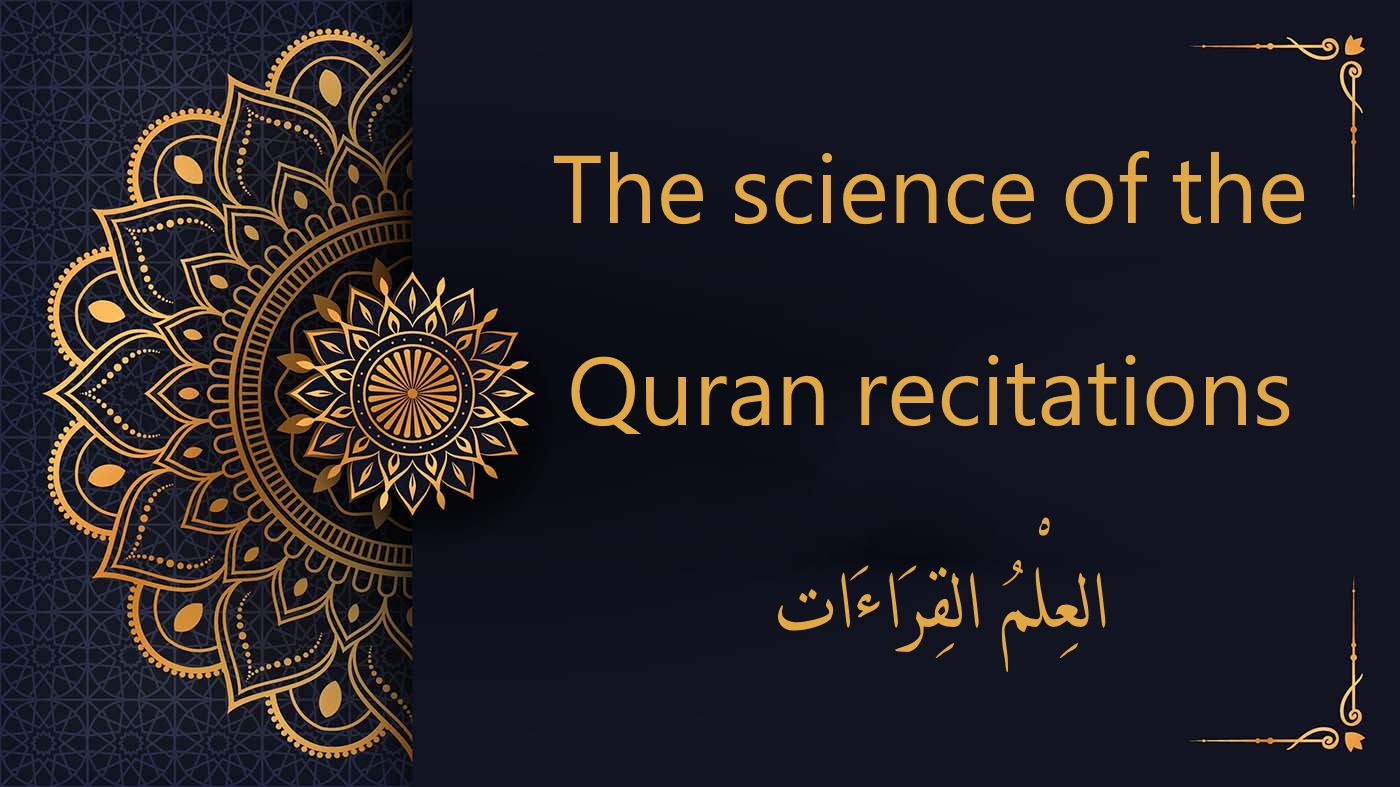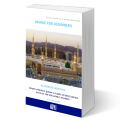
Quranic Recitation Science | العِلْمُ في قِرَاءَات القرآن
The science of Quranic recitations encompasses three pivotal areas:
- Mastery of Tajweed principles.
- Understanding the varied styles of recitation.
- Exploring the diverse learning modalities.
Understanding the Principles of Tajweed
Tajweed is bifurcated into:
-
Theoretical Rules: This encompasses the foundational principles of Tajweed, detailing standards and designations like the prolongation rules (ahkam al madd) and the rules concerning Noon Sakina and Tanween. Mastery of this domain is a collective obligation (Fard Kifaya) upon the Muslim community.
-
Practical Implementation: This domain stresses the importance of accurately applying Tajweed rules during Quranic recitation. The aim is to emulate the recitation style of Prophet Muhammad (peace be upon Him) as he was taught by Angel Jibril. This is an individual obligation for every Muslim intending to recite or memorize portions of the Holy Quran.
Tajweed and recitation scholars emphasize the indispensable nature of reciting the Holy Quran in the same manner that Prophet Muhammad (peace be upon Him) did, passed down from Jibril (peace be upon Him). This tradition traces back to the Prophet’s companions and the subsequent generations of scholars.
Supporting this, Allah the Almighty declares in the Holy Quran:
أَوْ زِدْ عَلَيْهِ وَرَتِّلِ الْقُرْآنَ تَرْتِيلًا
Or add to it, and recite the Qur’an with measured recitation. (73:4)
He, SWT, also says:
الَّذِينَ آتَيْنَاهُمُ الْكِتَابَ يَتْلُونَهُ حَقَّ تِلَاوَتِهِ أُولَـٰئِكَ يُؤْمِنُونَ بِهِ
Those to whom We have given the Book recite it with its true recital. They [are the ones who] believe in it. (2:221)
To truly honor the revelation, one must recite the Holy Quran as intended. Proper recitation involves:
- Prioritizing clarity and precision in your Quranic elocution.
- Ensuring the accuracy of each letter’s articulation point.
- Delivering each letter with its exact sound for a flawless rendition, striving always for perfection.
Understanding the Various Modes of Quranic Recitation
Origins of the Recitation Variations
At first, the revelation was only done in one “letter” (harf – huruf), then the Messenger of Allah (peace be upon Him) asked Jibril until the Angel taught him to recite the Quran following seven “letters”.
Ibn Abbas (may Allah be pleased with him) narrated that the Prophet (peace be upon him) mentioned:
“Initially, Jibril taught me to recite the Quran in a single ‘form’ (harf). Upon my repeated requests, he increased the ‘forms’ to seven.” (This hadith is recorded by al-Bukhari and Muslim.)
It’s commonly misconstrued that these seven ‘Harf’ correspond to the seven distinct “recitations.” However, this interpretation needs a deeper exploration, as we will elucidate later, inshAllah.
In Surah Al-Hajj, Allah the Almighty provides further insight in verse 11:
وَمِنَ النَّاسِ مَن يَعْبُدُ اللَّـهَ عَلَىٰ حَرْفٍ
And of the people is he who worships Allah on edge (harf).
In this context, the term “harf” can be understood as a “manner” or “style” (as referenced in the verse “on edge”).
Omar Ibn Al Khattab (may Allah be pleased with him) once narrated:
“While I was listening, Hisham ibn Hakim was reciting Surah al Furqan in a manner different from how the Messenger of Allah (peace be upon Him) had taught me. I was on the verge of intervening during his recitation but held back. Once he finished, I gripped his clothing and brought him to the Prophet, saying, ‘O Messenger of Allah, I heard him recite the Quran differently from how you taught me.‘
The Messenger of Allah (peace be upon Him) instructed, ‘Recite,’ to Hisham. He then recited in the same unique manner I had heard earlier.
The Prophet (peace be upon Him) remarked, ‘It was revealed in this way.‘
Then, turning to me, he said, ‘You recite.‘ As I did, he affirmed, ‘It was revealed in this way too. Truly, the Quran was sent down in seven different manners. So, recite it in the way that’s easiest for you.’“
(This hadith is sourced from both al-Bukhari and Muslim.)
Do the various Quranic recitations stem from different dialects?
The hadith previously cited offers a crucial insight into the diverse recitations of the Quran.
While many attribute the varied readings primarily to the different dialects prevalent at the time, it’s essential to realize that dialectical variations aren’t the sole reason. Yes, dialects played a significant role, but there were other underlying reasons.
Taking the example of Hisham and Omar Ibn Al Khattab, both belonged to the Quraysh tribe but from different clans – Hisham from the Assad and Omar from the Adiy. Notably, the Quraysh, despite being one tribe, had a singular dialect.
Scholars have delved deep into this topic, presenting nearly 40 different perspectives, yet the dialect argument remains predominant. However, it’s imperative to note that the differences in recitations pertain more to the specific terms used rather than their inherent meanings. This is evident from Omar Ibn Al Khattab’s reaction in the hadith; his contention was with the phrasing, not the conveyed message.
These varied “letters” or modes of recitation serve as a testament to the Quran’s richness and flexibility. Allah, in His infinite wisdom, intended to make the Quran accessible and straightforward for His creations, ensuring that its recitation wouldn’t pose a challenge.
Understanding Quranic Variations: The Ten Readings, Seven Recitations, and Seven Ahruf Explained
The realm of Quranic recitations, known as “Qira’at,” is both vast and intricate. The ten readings we recognize today are derived from a harmonious blend of both divine revelation and scholarly diligence. The concept of the “seven recitations” is not directly mentioned in the Quran or Sunnah; rather, it’s a product of the scholarly endeavor of Ibn Mujahid (may Allah have mercy on him).
It’s a misconception held by many that the seven recitations correspond directly to the “seven ahruf” or modes mentioned in the Sunnah. In reality, these two sets of seven are distinct, with their confluence being purely coincidental.
Later scholars expanded upon Ibn Mujahid’s categorization, and three more recitations were authenticated, bringing the total to ten. Each of these ten readings, while diverse, is linked through impeccable chains of transmission back to the Prophet (peace be upon Him) and respects all seven of the originally acknowledged modes or ahruf.
Across these ten readings, some verses can have up to seven different variations. However, it’s essential to note that the majority of verses have only one version.
Among the most esteemed recitations are:
- Ibn ‘Amr (from Shâm), who passed away in 118 AH. His students, Ibn Dhakwân and Hichâm, propagated his reading.
- Ibn Katheer (from Mecca), who left us in 120 AH, was taught further by Al Bazzy and Qunbool.
- Nafi’ (from Medina), who died in 169 AH. His reading was disseminated by Qaloon and Warsh.
- ‘Asim (from Kufa, Iraq), departed in 127 AH. Shu’ba and Hafs, his students, championed his recitation.
- Hamza (also from Kufa), whose life ended in 156 AH. Khalaf and Khallad took his reading forward.
- Abu ‘Amru (from Basra, Iraq), who left the world in 154 AH. His reading was passed on by Ad Doury and As Soussy.
- Al Kassai (from Kufa) passed away in 189 AH. Abu Al Hârith and Ad Doury were his main proponents.
To complete the list of ten, scholars acknowledged the readings of:
- Khalaf (from Kufa), who died in 229 AH. Idris and Ishaq relayed his reading.
- Abu Ja’far (from Medina), whose life ended in 130 AH. His reading was championed by Ibn Wardan and Ibn Jammaz.
- Ya’qub (from Kufa), who departed in 205 AH. Rooais and Rawh carried on his recitation.
These ten readings, endorsed by scholars throughout the ages, serve as a testament to the diversity and richness of the Quran’s linguistic and phonetic depth, ensuring its accessibility and resonance across the diverse Arab tribes and dialects of the time.
What are the meanings of the words "qary قارِئ," "rawy راوِي," and "Tariq طَريق"?
In a simplified summary, the process of transmitting knowledge through generations in the field of Quranic recitation can be explained as follows:
-
Qary (قارِئ): A Qary is a Quranic reader, someone who is highly skilled in reciting the Quran with precision and accuracy.
-
Rawy (راوِي): Rawy refers to the students of a Qary who learn directly from them. These students are essentially reporters or narrators of the Quranic recitation, ensuring its faithful transmission.
-
Tariq (طَريق): The Tariq represents the path or chain of transmission. It includes not only the Qary and their immediate students (Rawy) but also all the subsequent generations of students who learn from those Rawy and pass down the recitation tradition. In essence, the Tariq is the lineage of transmission, safeguarding the accurate recitation of the Quran.
For example, let’s consider Asim, a Qary. He has two Rawy, Chu’ba and Hafs, who directly learned from him. Then, two recognized students of Hafs, Amru and Ubayd ibn Sabah, report from him. Following this, El Fil and Zaraan learn from Amru, and the chain continues.
The different learning modes
In the art of Quranic recitation, the first level, known as “التَّحْقِيق” or “at-tahqiq,” focuses on precision and meticulous attention to detail. This level involves a thorough understanding and mastery of various aspects of Quranic pronunciation:
-
Letters’ Sounds: The reader must fully realize the correct sounds of each Arabic letter. Proper articulation is crucial to maintain the integrity of the Quranic text.
-
Long and Short Vowels: At tahqiq requires a precise differentiation between long and short vowels. These nuances are essential for the accurate recitation of the Quran.
-
Hamza (ء): The correct pronunciation of the hamza, a unique Arabic letter, is emphasized. It may appear at the beginning, middle, or end of words and requires specific articulation.
-
Recitation Pace: During at-tahqiq, recitation should be calm and deliberate, with a slow pace. This deliberate pace aids in the careful enunciation of every letter and vowel.
It’s important to note that at-tahqiq is primarily done for educational purposes to ensure a thorough understanding of the rules of Quranic recitation. However, it’s crucial to strike a balance, as overly elongating certain letters or vowels can lead to unnatural and incorrect recitation.
Example of Tahqiq Recitation of the Holy Quran:
The second level, known as “الحَدْرُ” or “al hadr,” involves dynamic recitation. In this level, recitation is characterized by a faster pace while still adhering to the rules of Tajweed, which are the rules governing the proper pronunciation of the Quranic text.
Example of Al Hadr Recitation of the Holy Quran:
The third level, known as “التَّدْوِيْرُ” or “at-tadwir,” is often referred to as “tajweed” and represents an intermediate stage of Quranic recitation. It serves as a bridge between the precision-focused “tahqiq” and the dynamic “al-hadr” levels.
Example of Tadwir (Tajweed) Quran Recitation:
Historically, during the time of the Prophet (peace be upon Him), the concept of Tajweed, or the precise and proper recitation of the Quran, didn’t require elaborate theorization. This was because the Quran was revealed in the language of the people, and they inherently understood the correct pronunciation and rules of their own language.
However, as the Islamic community expanded to include non-Arabic speakers and as the Arabic language itself evolved into various dialects, it became increasingly necessary to formalize and define the rules governing the language and, specifically, the recitation of the Holy Quran.
In the practice of correcting Quranic recitation, the role of a qualified individual is paramount. While it’s possible to learn these rules from books or online resources, the guidance of a knowledgeable mentor with a trained ear is essential to ensure accurate correction and recitation.
For those seeking to improve their Quranic recitation, it is crucial to find a recognized and competent teacher in their local community. The correction process should ideally begin with fundamental aspects of recitation that pertain to one’s religious practice. A priority is to refine the recitation of Surah Al-Fatiha, as it constitutes a fundamental pillar of Islamic prayer. It is imperative to rectify any significant errors in its recitation.
In cases where locating a qualified teacher is challenging, individuals can make efforts to self-correct by listening to audio recordings and closely studying the Quran. There are several key references one can use for this purpose:
-
Audio Recordings: Listening to expert recitations can provide valuable guidance on proper pronunciation and Tajweed rules.
-
The Quran Itself: Directly listening to and reciting the Quran can help internalize correct pronunciation and rhythm.
-
Educational Resources: Utilizing trusted educational materials and online resources can aid in understanding and practicing Tajweed rules.
In essence, while formal Tajweed instruction from a qualified teacher is highly recommended, individuals who are unable to find such guidance should make diligent efforts to self-improve by relying on available resources and continuous practice.
Conclusion
The lesson on Tajweed rules concludes here. Insha’Allah, the next lesson will focus on identifying and rectifying common mistakes made by individuals while reciting the Holy Quran.
At the Al-dirassa Institute, we provide an accessible path to mastering Tajweed under the guidance of skilled instructors. Should you wish to pursue this further, we warmly invite you to reach out to us.
Chosen and Trusted by Thousands of Satisfied Learners
Discover the experiences of our delighted clients who have thoroughly enjoyed utilizing this standout feature.
Alhamdulillah I‘m very pleased with the arabic and Qur’an lessons I receive from teacher Umm Tasneem and I‘m also content with the al-dirassa administration team who were very quick in answering any questions I had. In a month I progressed a lot and I cannot wait to continue my studies with al-dirassa. May Allah reward everyone at al-dirassa.
 Verified review - view original
Verified review - view original
My Qur’an teacher is fantastic, she teaches me in a loving and kind way where I look forward to the lessons and learn so much. My Arabic teacher is equally as nice and has a lot of patience with me, she has great expertise in the field and I’ve progressed really quickly with her. Thank you Al-dirassa!
 Verified review - view original
Verified review - view original
Book your free trial lesson
Don’t want to go through the translation anymore?
30 free minutes with your qualified Egyptian teacher.




